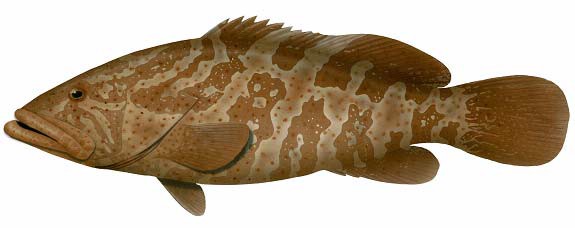
Estuary cod
Epinephelus coioides

Estuary cod occur in tropical and warm temperate marine waters of the Indo-Pacific including the Persian Gulf, India, the Philippines, Singapore, Hong Kong, Taiwan, Fiji and around numerous other islands. In Australia they are most common in Queensland, the Northern Territory and Western Australia; however, they are known to occur as far southwards as the Sydney area.
Estuary cod inhabit turbid coastal reefs and are often found in brackish water over mud and rubble. They are frequently misidentified as Epinephelus tauvina (Greasy grouper) or Epinephelus malabaricus (Malabar grouper), which look similar and have overlapping distributions. Estuary cod also have a variety of common names including estuary rock cod, orange-spotted grouper, orange-spotted cod, green grouper, greasy cod, spotted river cod and brown-spotted grouper.
Estuary cod are widely grown in aquaculture in Asian countries such as Singapore and Taiwan; however, the different species (E. coioides and E. malabaricus) have not been distinguished during most of the production.
Estuary cod are listed as a protected fish in NSW under the Fisheries Management Act 1994. Heavy penalties apply for taking or possessing them.
Description
Estuary cod are brown above and whitish below. They have four to six dark-coloured bands running diagonally from top to bottom across their body. There are numerous small orange- brown spots on the head, body and fins. The spots are pupil-sized in small fish but become relatively smaller and more numerous as the fish ages. The spots can range in colour from orange-red to brown. Estuary cod may grow to 180 cm (100 kg) but are more commonly around 40–120 cm long and up to 25 kg.
Habitat and ecology
- Estuary cod are commonly found in the lower reaches of estuaries and protected silty reef habitats. They occur on coral reefs in turbid areas as well as in brackish environments.
- Adult estuary cod are usually found at the bases of small drop-offs associated with large caves or shipwrecks. Specimens have been recorded at depths up to 100 m.
- Juvenile estuary cod are common in shallow waters of estuaries over sand, seagrass, mud and gravel and among mangroves, and they have also been reported from freshwaters.
- The major spawning period for estuary cod is from March to June and females reach sexual maturity at 25–30 cm total length and produce vast numbers of eggs. Adults may form aggregations when mating. Eggs and early larvae are pelagic and do best in warm waters of about 30°C.
- The majority of tropical Australian estuary cod populations consist almost entirely of pre- productive females. Estuary cod have an unusual reproductive cycle with some females changing sex to become males when they are about 50–75 cm long.
- Estuary cod can be solitary or form small groups and usually exist within a small home range of approximately 80 m.
- Estuary cod feed upon a variety of animals including fish, shrimp, cuttlefish and crab.
- They are capable of living to at least 17 years.
- NSW waters are at the southern extent of the species’ Australian distribution. The species is susceptible to depletion due to its unusual reproductive cycle, long life, and territorial nature.
- Estuary cod are particularly vulnerable to spearfishing, recreational line fishing, and commercial fishing.
- Maintaining bans on taking estuary cod in NSW waters, and protecting them from illegal fishing or spearfishing.
- Educating fishers on the best ways to return any incidentally caught estuary cod to the water.
- Protection of important estuarine nursery habitats.
- Estuary cod habitat is located in a number of protected areas in NSW including the Solitary Islands Marine Park, Julian Rocks Aquatic Reserve and Cook Island Aquatic Reserve.
Why are estuary cod protected?
What conservation actions are underway?
Legal implications
Taking or possessing estuary cod (or any other species of protected fish) is an offence and heavy penalties apply. For corporations these penalties can include fines of up to $55 000 while individuals can face fines of up to $11 000 and up to 3 months in prison.
Bibliography and further reading
Kuiter RH 1996, Guide to sea fishes of Australia, New Holland, Frenchs Forest, NSW, Australia, 433 pp.
Randall JE, Allen GR & Steene RC 1997, Fishes of the Great Barrier Reef and Coral Sea, revised edition, Crawford House, Bathurst, NSW,
557 pp.
For further information
For more information on general fishing regulations check with your local fisheries office or visit www.dpi.nsw.gov.au/fisheries
To contact your local NSW Fisheries Office visit https://www.dpi.nsw.gov.au/contact-us/contact-a-dpi-fisheries-officer or phone 1300 550 474.

